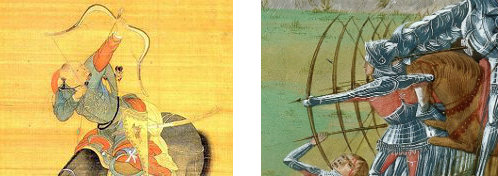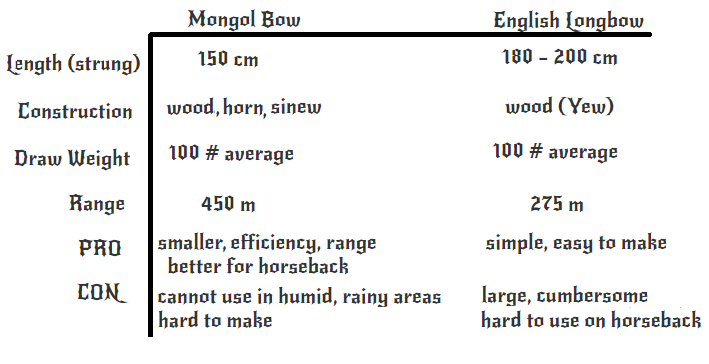Mongolian Bow VS English Longbow – Advantages and Drawbacks
Mongolian Bow VS English Longbow – Advantages and Drawbacks
Mongolian Bow VS English Longbow. Which bow is better? Both weapons dominated the battlefield in the 12th and 13th centuries (A.D) in their respective regions. Each bow has it’s own advantages and drawbacks. These bows evolved in very different geographical regions and were adapted for use in different ways. The Mongols shot their composite horsebows from horseback. These bows were made from a combination of materials, and were able to store and release energy much more efficiently than longbows. The English Longbow on the other hand is made from a single branch, typically from Yew. Manufacturing the longbow requires much less time, and the bows are less susceptible to damage from the elements. Let us examine and compare the advantages and drawbacks of both bows.
Construction and Materials
As mentioned, the Mongolian bow is made of a combination of wood, sinew and horn, layered and glued together with fish bladder glue. The Mongol bow is has more reflex, meaning that it is curved in the opposite direction when unstrung then when strung. The composite bow is more tense when strung compared to the longbow. The Longbow accelerates the arrow only at the beginning of the release, while the composite bow of the Mongols accelerates the projectile throughout the entire motion from full draw.
Because of the geometry of the bow, and the materials from which it is made, the Mongolian bow is more efficient that the Longbow. What does this mean? A Mongolian bow with a hundred (100) pound draw weight can shoot the same arrow as an English Longbow of the same draw weight farther and faster. The limbs of the Mongolian bow store and release energy more efficiently. They travel faster, and spring back to position quicker when the archer releases the string as compared to the longbow. The English Longbow requires more of the energy it has stored to overcome the inertia of it’s own limbs. The longbows of old were cut and carved from a single branch of the Yew tree.

Techniques and Use
A Mongolian bow is a cavalry weapon and an English Longbow is used on foot. One can draw a much heavier bow on foot compared to being mounted. Leveraging the use of their lower bodies, English archers drew very heavy bows, most averaging around 100 pounds. The English bowmen of the Hundred Year’s War fought with France, showered the French nights with heavy, armor piercing arrows. The Mongol’s arrows were intended to be used on more lightly armored adversaries. One main drawback of a Mongolian bow, compared to an English longbow, is that composite bows require much more time and labor to make.
Some composite bows remain in a jig, with their different layers bound together for several months or even years. A longbow can be cut and carved in a single day. Longbows are also not as delicate to maintain and are not as susceptible to the elements like the composite bows. A composite bow will loose it’s energy storing ability faster than a longbow if left strung for extended periods of time. The composite bows must be unstrung and left to relax in order to better maintain their effectiveness. Because the longbow does not use any glues and is made from a single piece of wood, it is not susceptible to humidity and moisture like the Mongolian bow.
